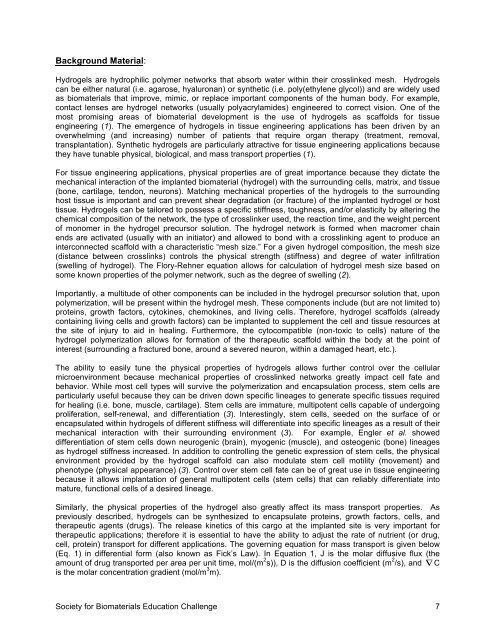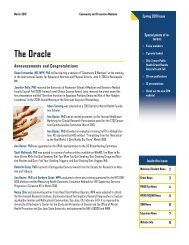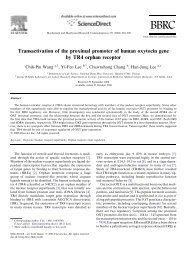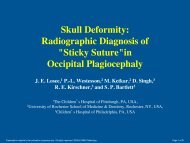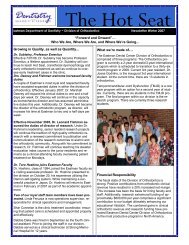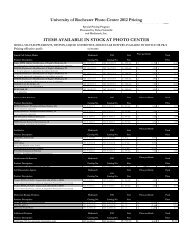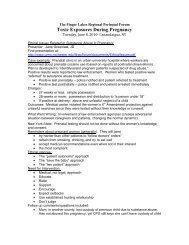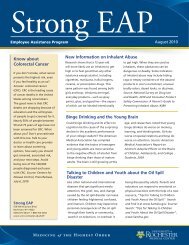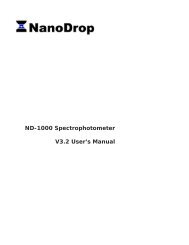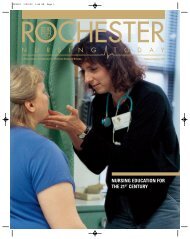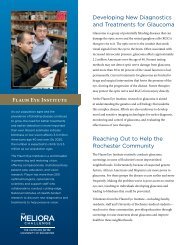SFB Education Challenge - UR_2013 - University of Rochester ...
SFB Education Challenge - UR_2013 - University of Rochester ...
SFB Education Challenge - UR_2013 - University of Rochester ...
Create successful ePaper yourself
Turn your PDF publications into a flip-book with our unique Google optimized e-Paper software.
Background Material:Hydrogels are hydrophilic polymer networks that absorb water within their crosslinked mesh. Hydrogelscan be either natural (i.e. agarose, hyaluronan) or synthetic (i.e. poly(ethylene glycol)) and are widely usedas biomaterials that improve, mimic, or replace important components <strong>of</strong> the human body. For example,contact lenses are hydrogel networks (usually polyacrylamides) engineered to correct vision. One <strong>of</strong> themost promising areas <strong>of</strong> biomaterial development is the use <strong>of</strong> hydrogels as scaffolds for tissueengineering (1). The emergence <strong>of</strong> hydrogels in tissue engineering applications has been driven by anoverwhelming (and increasing) number <strong>of</strong> patients that require organ therapy (treatment, removal,transplantation). Synthetic hydrogels are particularly attractive for tissue engineering applications becausethey have tunable physical, biological, and mass transport properties (1).For tissue engineering applications, physical properties are <strong>of</strong> great importance because they dictate themechanical interaction <strong>of</strong> the implanted biomaterial (hydrogel) with the surrounding cells, matrix, and tissue(bone, cartilage, tendon, neurons). Matching mechanical properties <strong>of</strong> the hydrogels to the surroundinghost tissue is important and can prevent shear degradation (or fracture) <strong>of</strong> the implanted hydrogel or hosttissue. Hydrogels can be tailored to possess a specific stiffness, toughness, and/or elasticity by altering thechemical composition <strong>of</strong> the network, the type <strong>of</strong> crosslinker used, the reaction time, and the weight percent<strong>of</strong> monomer in the hydrogel precursor solution. The hydrogel network is formed when macromer chainends are activated (usually with an initiator) and allowed to bond with a crosslinking agent to produce aninterconnected scaffold with a characteristic “mesh size.” For a given hydrogel composition, the mesh size(distance between crosslinks) controls the physical strength (stiffness) and degree <strong>of</strong> water infiltration(swelling <strong>of</strong> hydrogel). The Flory-Rehner equation allows for calculation <strong>of</strong> hydrogel mesh size based onsome known properties <strong>of</strong> the polymer network, such as the degree <strong>of</strong> swelling (2).Importantly, a multitude <strong>of</strong> other components can be included in the hydrogel precursor solution that, uponpolymerization, will be present within the hydrogel mesh. These components include (but are not limited to)proteins, growth factors, cytokines, chemokines, and living cells. Therefore, hydrogel scaffolds (alreadycontaining living cells and growth factors) can be implanted to supplement the cell and tissue resources atthe site <strong>of</strong> injury to aid in healing. Furthermore, the cytocompatible (non-toxic to cells) nature <strong>of</strong> thehydrogel polymerization allows for formation <strong>of</strong> the therapeutic scaffold within the body at the point <strong>of</strong>interest (surrounding a fractured bone, around a severed neuron, within a damaged heart, etc.).The ability to easily tune the physical properties <strong>of</strong> hydrogels allows further control over the cellularmicroenvironment because mechanical properties <strong>of</strong> crosslinked networks greatly impact cell fate andbehavior. While most cell types will survive the polymerization and encapsulation process, stem cells areparticularly useful because they can be driven down specific lineages to generate specific tissues requiredfor healing (i.e. bone, muscle, cartilage). Stem cells are immature, multipotent cells capable <strong>of</strong> undergoingproliferation, self-renewal, and differentiation (3). Interestingly, stem cells, seeded on the surface <strong>of</strong> orencapsulated within hydrogels <strong>of</strong> different stiffness will differentiate into specific lineages as a result <strong>of</strong> theirmechanical interaction with their surrounding environment! (3). For example, Engler et al. showeddifferentiation <strong>of</strong> stem cells down neurogenic (brain), myogenic (muscle), and osteogenic (bone) lineagesas hydrogel stiffness increased. In addition to controlling the genetic expression <strong>of</strong> stem cells, the physicalenvironment provided by the hydrogel scaffold can also modulate stem cell motility (movement) andphenotype (physical appearance) (3). Control over stem cell fate can be <strong>of</strong> great use in tissue engineeringbecause it allows implantation <strong>of</strong> general multipotent cells (stem cells) that can reliably differentiate intomature, functional cells <strong>of</strong> a desired lineage.!Similarly, the physical properties <strong>of</strong> the hydrogel also greatly affect its mass transport properties. Aspreviously described, hydrogels can be synthesized to encapsulate proteins, growth factors, cells, andtherapeutic agents (drugs). The release kinetics <strong>of</strong> this cargo at the implanted site is very important fortherapeutic applications; therefore it is essential to have the ability to adjust the rate <strong>of</strong> nutrient (or drug,cell, protein) transport for different applications. The governing equation for mass transport is given below(Eq. 1) in differential form (also known as Fick’s Law). In Equation 1, J is the molar diffusive flux (theamount <strong>of</strong> drug transported per area per unit time, mol/(m 2 s)), D is the diffusion coefficient (m 2 /s), and Cis the molar concentration gradient (mol/m 3 m).Society for Biomaterials <strong>Education</strong> <strong>Challenge</strong> 7!


